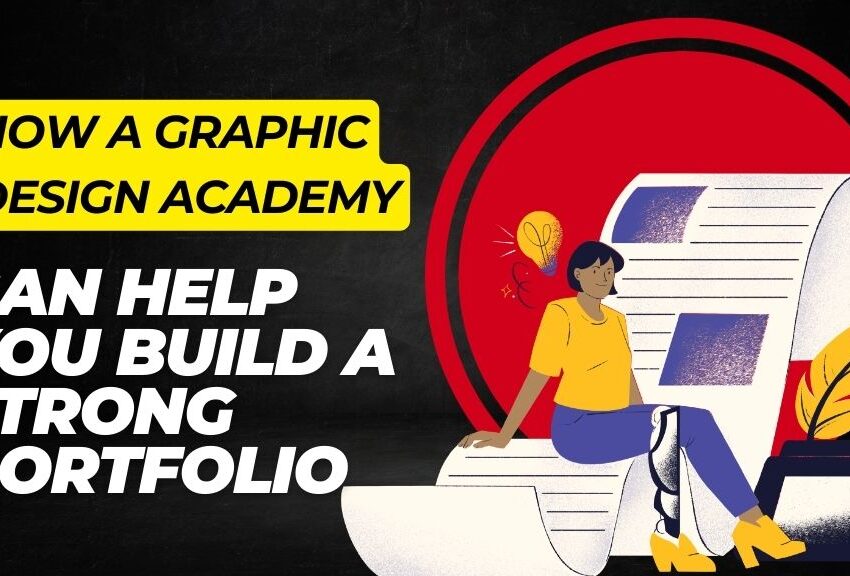
How a Graphic Design Academy Can Help You Build a Strong Portfolio
In the world of design, your portfolio is your identity. It’s not just a collection of work — it’s proof of your creativity, your technical skills, and your ability to solve real-world design problems. Whether you’re aiming for a freelance gig, a full-time job, or your dream design school, a strong graphic design portfolio is non-negotiable.
So how do you build one?
That’s where a Graphic Design Academy comes in. In this blog, we’ll explore how enrolling in a professional graphic design course can help you create a standout portfolio that opens doors to endless opportunities.
What Is a Graphic Design Portfolio?
A graphic design portfolio is a curated collection of your best work, showcasing:
- Your design style and aesthetics
- Your ability to handle different types of projects
- Your technical proficiency in tools like Photoshop, Illustrator, CorelDRAW, etc.
- Your creative problem-solving and conceptual thinking
In short, it tells clients and employers:
“Here’s what I can do for you.”
How a Graphic Design Academy Helps You Build Your Portfolio
1. Structured Learning from Basics to Advanced
A good academy starts from the fundamentals of design — color theory, typography, layout — and gradually moves into real-world tools and techniques.
You’ll learn how to:
- Use industry-standard software
- Follow design principles and branding guidelines
- Work with design briefs like real clients do
This foundation helps you build quality work that deserves a place in your portfolio.
2. Live Projects & Practical Assignments
Top graphic design institutes focus on hands-on learning. You’ll work on:
- Logo design
- Social media creatives
- Brochures, flyers, and posters
- Website mockups & app UI
- Branding kits
- Packaging design
Each project you complete becomes a potential portfolio piece, especially when guided by experienced mentors.
3. Creative Feedback & Mentorship
Design is subjective, but good feedback sharpens your skills. In an academy, mentors:
- Review your work critically
- Suggest improvements
- Teach you how to present your design thinking
This is essential for polishing rough work into professional-grade portfolio content.
4. Portfolio Building Sessions
Many academies include dedicated sessions on how to:
- Choose your best projects
- Write compelling project descriptions
- Arrange your work for impact
- Create both offline (PDF) and online (website/Behance/Dribbble) versions of your portfolio
They guide you in packaging your work professionally to impress employers and clients.
5. Mock Client Briefs & Real-World Scenarios
Instead of random practice tasks, you’ll be given real-world design problems like:
- Creating a visual identity for a startup
- Designing a responsive website layout
- Making marketing materials for a product launch
These projects reflect actual job requirements and help you demonstrate your value in a professional setting.
6. Internships & Freelance Opportunities
Many graphic design academies offer internship support or connect you with freelance gigs, giving you a chance to:
- Work with real clients
- Understand timelines and expectations
- Get published work for your portfolio
These experiences add credibility and show that your work isn’t just academic — it’s impactful.
Why a Strong Portfolio Matters in Graphic Design
Your portfolio helps you:
✅ Land design jobs and freelance projects
✅ Stand out in interviews
✅ Apply to top design colleges or agencies
✅ Build a professional online presence
✅ Win the trust of clients and employers
In creative fields, your portfolio often speaks louder than your resume.
Looking for the Right Graphic Design Academy in Ahmedabad?
Here’s what you should look for:
✅ Experienced mentors & industry experts
✅ Practical training with real-world projects
✅ Adobe Photoshop, Illustrator, CorelDRAW, Figma training
✅ Portfolio creation guidance
✅ Internship & placement support
✅ Small batch sizes for personal attention
Choose an academy that focuses on your growth — not just software tools.
Bonus Tips to Build a Portfolio That Gets Noticed
- Include a short story or process behind each project
- Show before/after redesigns if possible
- Highlight the problem you solved with your design
- Use platforms like Behance, Dribbble, and LinkedIn to share your work
- Keep updating your portfolio with new and better work
Final Thoughts
Enrolling in a Graphic Design Academy isn’t just about learning software — it’s about building your identity as a designer. With expert guidance, practical experience, and a focus on portfolio building, you’ll be prepared to showcase your talent, impress employers, and get hired.
Remember: Your portfolio is your ticket to the design world. Make it count.




Leave a Comment